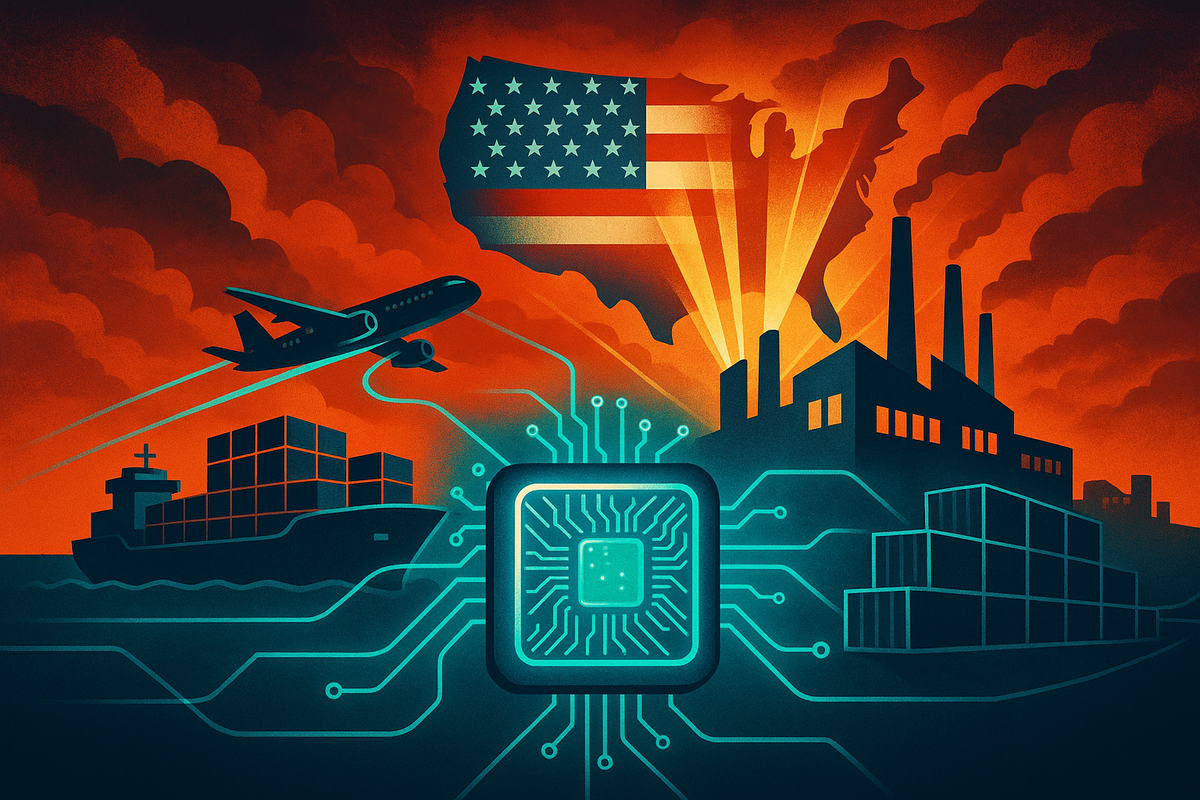Financial News
Trump's Tariff Threat Ignites Semiconductor Sector, Reshaping Global Supply Chains

President Donald Trump has sent shockwaves through the global technology landscape with a bold proposal: a 100% tariff on semiconductors manufactured overseas, unless companies commit to establishing or expanding manufacturing operations within the United States. This aggressive stance, announced on August 6, 2025, during a meeting with Apple (NASDAQ: AAPL) CEO Tim Cook, aims to dramatically accelerate the reshoring of chip production, a critical component of modern electronics. The immediate implications are profound, signaling a potential seismic shift in global supply chains and a significant increase in costs for consumers, while simultaneously sparking a rally in the shares of domestic semiconductor and equipment manufacturers.
A High-Stakes Gamble: Trump's Tariff Ultimatum and Its Rationale
President Trump's declaration of a "approximately 100%" tariff on imported chips is a direct challenge to the established global semiconductor ecosystem. The core of his proposal lies in a crucial exemption: companies actively building or committed to building manufacturing facilities in the U.S. will face no such levy. This "America First" approach is a stark contrast to the Biden administration's CHIPS and Science Act, which offered substantial financial incentives for domestic production. Trump's strategy, however, employs a "stick over carrots" methodology, leveraging punitive tariffs to compel investment.
The announcement followed closely on the heels of Apple's pledge of an additional $100 billion in U.S. manufacturing investments, bringing their total commitment to $600 billion over the next four years. This timing suggests a strategic alignment, with Apple seemingly securing an exemption through its substantial domestic investment. The move is designed to bolster American manufacturing jobs, enhance national security by reducing reliance on foreign chip sources, and potentially gain a political advantage ahead of future elections. However, it also introduces significant uncertainty and potential disruption for an industry deeply intertwined with international trade.
Key players in the global semiconductor industry, such as Taiwan Semiconductor Manufacturing Company (NYSE: TSM), Samsung Electronics (KRX: 005930), and SK Hynix (KRX: 000660), which have already committed to or are in the process of establishing U.S. facilities, are reportedly exempt from the proposed tariffs. This selective application highlights the policy's intent to reward domestic investment rather than to universally penalize all foreign production. Nevertheless, the broad threat of a 100% tariff has sent ripples of concern through international markets, particularly in Asia, where many critical components are manufactured.
Winners and Losers in the Tariff Tug-of-War
The proposed tariffs have created a clear divide between potential winners and losers in the semiconductor and related industries. Companies with significant existing or planned U.S. manufacturing capabilities stand to benefit immensely, as they would avoid the crippling tariffs and potentially gain a competitive edge in the domestic market. Conversely, firms heavily reliant on overseas production without a U.S. manufacturing footprint face the prospect of drastically increased costs, which would likely be passed on to consumers, making their products less competitive.
Among the clear winners are U.S.-based semiconductor equipment manufacturers. Companies like Applied Materials (NASDAQ: AMAT), Lam Research (NASDAQ: LRCX), and KLA Corporation (NASDAQ: KLAC) are poised for a surge in demand as chipmakers accelerate their plans to build or expand facilities in the United States. The need for advanced machinery and tools to equip these new fabs will directly translate into increased orders and revenue for these companies. Similarly, domestic chipmakers with substantial U.S. operations, such as Micron Technology (NASDAQ: MU), which has been expanding its U.S. manufacturing, could see a significant boost.
However, the situation for Intel (NASDAQ: INTC) presents a unique paradox. Despite its long-standing commitment to U.S. manufacturing and significant investments in domestic fabs, the company's stock did not participate in the broader semiconductor rally. This anomaly is attributed to President Trump's public criticism of Intel's CEO, Pat Gelsinger, regarding the pace of their U.S. expansion. This highlights the highly personalized nature of the proposed policy and the potential for political rhetoric to directly impact individual corporate valuations, even for companies seemingly aligned with the policy's goals. Overseas manufacturers without U.S. commitments, particularly those in China and other parts of Asia, face the most significant threat, as their products would become prohibitively expensive in the U.S. market.
Industry Impact and Broader Implications
President Trump's proposed 100% tariff on overseas semiconductors represents a significant escalation in the ongoing global competition for technological supremacy and supply chain resilience. This move fits squarely into a broader trend of nations seeking to onshore critical industries, particularly after the supply chain disruptions experienced during the COVID-19 pandemic. The semiconductor industry, being the foundational technology for virtually all modern electronics, is at the forefront of this strategic realignment.
The potential ripple effects of such a tariff are vast. Beyond the immediate impact on chipmakers, industries that heavily rely on semiconductors, such as automotive, consumer electronics, and defense, would face increased production costs. This could lead to higher prices for everything from smartphones and cars to household appliances, ultimately burdening consumers. Furthermore, the policy could provoke retaliatory measures from trading partners, potentially leading to a global trade war over critical technologies. Countries like Singapore, deeply integrated into global semiconductor value chains through supporting industries like precision engineering and logistics, are particularly concerned about the potential for widespread disruption.
Historically, tariffs have been used as a tool to protect domestic industries, but a 100% tariff is an exceptionally aggressive measure, rarely seen outside of specific trade disputes. Comparisons can be drawn to past trade tensions, such as the U.S.-China trade war, but the targeted nature and extreme percentage of this proposed tariff on a foundational technology make it unique. Regulatory and policy implications are also significant, as the implementation of such a tariff would require complex legal and administrative frameworks, potentially facing challenges from international trade organizations and domestic industry groups. The policy also raises questions about its compatibility with existing trade agreements and its long-term impact on global economic cooperation.
What Comes Next: Navigating the Tariff Landscape
The immediate future for the semiconductor industry is marked by a high degree of uncertainty and the need for strategic adaptation. In the short term, companies will be scrambling to assess their supply chains, evaluate the feasibility of accelerating U.S. manufacturing plans, and lobby policymakers for clarity and potential exemptions. The lack of detailed policy guidance has already led to "cautious watchfulness" across the industry, with concerns centered on supply chain disruption, rising costs, and the unpredictability of global trade flows.
In the long term, the proposed tariffs could fundamentally reshape the global semiconductor landscape. We may see a significant acceleration of "fab-building" in the U.S., leading to a more geographically diversified, albeit potentially more expensive, chip supply chain. This could create new market opportunities for domestic suppliers of materials, equipment, and skilled labor. However, it also presents significant challenges, including the immense capital investment required for new fabs, the availability of a skilled workforce, and the potential for reduced global competitiveness if U.S.-made chips become significantly more expensive.
Potential scenarios range from a full implementation of the 100% tariff, leading to a dramatic restructuring of the industry, to a more nuanced application with numerous exemptions and a phased approach. Companies may explore strategic pivots, such as forming joint ventures for U.S. manufacturing, or even divesting from certain product lines if the cost of compliance becomes prohibitive. The political landscape will also play a crucial role, as the outcome of future elections could either solidify or reverse this protectionist stance. Investors should closely monitor legislative developments, corporate announcements regarding U.S. investments, and any retaliatory measures from affected countries.
Conclusion: A New Era for Semiconductors
President Trump's call for a 100% tariff on overseas semiconductors marks a pivotal moment for the global technology industry. It underscores a growing nationalistic push to secure critical supply chains and re-establish domestic manufacturing prowess. The immediate market reaction, characterized by a rally in most semiconductor and equipment stocks (with the notable exception of Intel due to specific political commentary), highlights the market's belief that domestic production will be heavily favored.
Moving forward, the semiconductor industry faces a complex balancing act. While the allure of a protected domestic market is strong, the challenges of rapidly scaling U.S. manufacturing, managing increased costs, and navigating potential international trade disputes are substantial. Investors should assess companies based on their existing U.S. manufacturing footprint, their strategic plans for domestic expansion, and their ability to absorb or pass on increased costs. The coming months will be critical in determining the precise contours of this new era for semiconductors, as companies, governments, and consumers grapple with the implications of a potentially radical shift in global chip production. The lasting impact will likely be a more diversified, albeit potentially more expensive, global semiconductor supply chain, with significant implications for technological innovation and economic competitiveness worldwide.
More News
View More



Recent Quotes
View More
Quotes delayed at least 20 minutes.
By accessing this page, you agree to the Privacy Policy and Terms Of Service.




